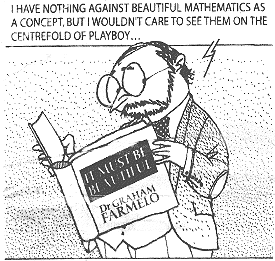 |
Beautiful thoughts marred by Einstein's ugly miscalculation
|
 |
To anyone who loathed school algebra,
the notion of mathematical beauty may sound unlikely,
yet among mathematicians there is no higher praise than to have a new result
hailed as not only merely correct but also beautiful
.
Opinions naturally differ about just how beautiful a particular
result truly is. Some years ago, a poll was taken among mathematicians to
find out which discovery was thought to be the most beautiful of them all.
The winner was a formula found by the Swiss mathematician Leonhard Euler
in 1748, which states that when one is added to the transcendental
number "e" (roughly 2.71828)raised to the power of pi (roughly
3.14159) multiplied by the square-root of minus
one, the result is precisely zero.
Combining the five most important numbers in all mathematics,
the formula is clearly a marvel of brevity. Yet it is the sheer
implausibility of any relationship existing between such disparate
numbers that gives Euler's formula its intellectual shock value. I
can still recall exactly where I was a quarter of a century ago when Mr Clark,
our A-level maths teacher, first wrote Euler's formula on the blackboard.
Among theoretical physicists, the search for
beauty among the equations counts for even more
than mere plaudits from their colleagues. For them it has become almost
an article of faith that, as Keats put it, "beauty is truth,
truth beauty".
As a fascinating new collection of essays on famous equations in modern science
shows (It Must Be Beautiful, Grants Books £20),it is a maxim
that has served physicists pretty well over the years, putting them on the
road to a "theory of everything". Yet as Graham
Farmelo, the editor of the collection, concedes, it has also occasionally
led scientists up the garden path.
Perhaps to spare their blushes, Dr Farmelo declines to give specific examples.
Having no such scruples, I shall therefore wade in with what to my mind is
a particularly salutary example.
It centres on attempts to find the equations governing the cosmos.
For most of human history, the universe was
thought to be infinite, everlasting and static - not least because the
alternatives were too mind-boggling to
contemplate.
One can thus understand Albert
Einstein's consternation when his general theory of relativity gave equations
showing that the universe was anything but static.
Until then, Einstein had relied on his physical
intuition and aesthetic
sense to guide him to the "right" equations.
Now he found that his beautiful equations gave a patently incorrect answer.
Reluctantly, therefore, he bolted on an ugly extra term to compel them into
giving a static universe.
A decade later, Einstein discovered that he had made the biggest
blunder of his life. Astronomers had found that the universe is expanding
after all - just as Einstein's original equations had shown. Incensed at
having ignored his own aesthetic instincts, Einstein dropped the ugly extra
term, and vowed never to deal with it again.
For the next 70 years cosmologists followed
suit, with such luminaries as Prof Stephen
Hawking coming up with elegant arguments for why Nature would never allow
the ugly extra term to sully Einstein's masterpiece.
Now it seems Nature has played another nasty trick on the theorists. Compelling
evidence has recently emerged that the ugly term not only exists, but that
it dominates the dynamics of the cosmos. It's enough to make the
aesthetes of physics fall into a swoon. I am sure it's only a matter
of time before they twig that there's a sense in which the ugly term is in
fact very beautiful. Put simply, its presence implies
that the cosmos is evolving to a state where it looks the same in all
directions.Such a state possesses "maximal space-time symmetry" and
even mathematical duffers know that symmetries are
very beautiful.
As the warthog once said about her offspring, beauty is sometimes just a
matter of looking at things is the right way.